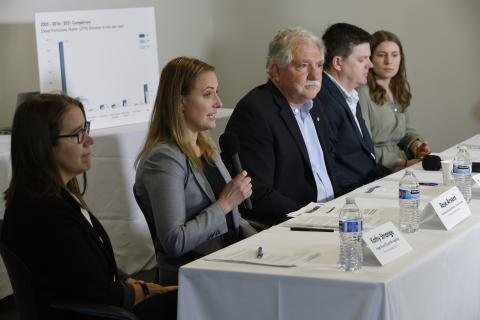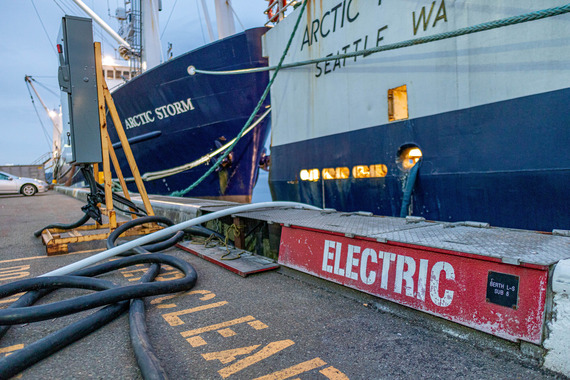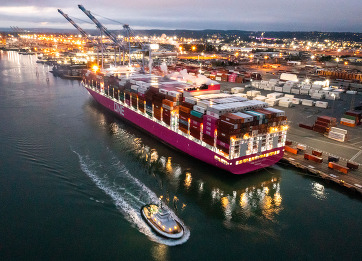|
Welcome to the Clean Air Quarterly, the newsletter for clean air and climate activities for the Northwest Seaport Alliance, the Port of Seattle and the Port of Tacoma (the Ports). Each newsletter will showcase projects and milestones across our gateway, features a team member or gateway partner who is making a difference in our region, and provides additional opportunities for community engagement, such as bus tours, commission meetings, and upcoming webinars!

In 2005 the Ports, in addition to several other partners, dedicated themselves to measuring the emissions in the Puget Sound airshed in order to quantify necessary areas for improvements to move us collectively toward a zero-emission future. To this end the Puget Sound Maritime Forum was formed, consisting of ports, private maritime organizations, air agencies, environmental and public health advocacy groups and other parties with operational or regulatory responsibilities related to the maritime industry.
This year the 2021 Puget Sound Emissions Inventory (PSEI) results were released. Collectively we have made a lot of strides, and still have a lot of work to do. Major federal and state investment is accelerating our ability to progress towards our shared goals. Notable in the PSEI report was an 87% reduction in diesel particulate matter since the 2005 inventory and 30% reduction since the last inventory. We also saw a 10% reduction in overall greenhouse gas emissions — important progress but below our desired outcome. It's also important to note that the COVID-19 pandemic disrupted cargo supply chain, cruise, and other maritime activities in 2021, which impacted results. Still, the 2021 PSEI provides important data for assessing progress towards our goal to phase out emissions and informing our emission reduction initiatives and investments in the coming years.
|
 RTG (Rubber Tired Gantry) cranes are a crucial piece of cargo handling equipment that move containers to different areas of a terminal. Very large cargo handling equipment like RTGs are extremely difficult to decarbonize due to their size, specialized nature and limited manufacturers. In the past year, two terminals have invested in cleaner, hybrid electric RTGs. Husky Terminal in Tacoma has purchased and is operating four new hybrid RTG cranes, and Terminal 5 in Seattle has three new hybrid RTGs that arrived with the two new electric Super Post-Panamax cranes the terminal added this year.
The transition from diesel to plug-in hybrid electric equipment will result in a substantial reduction in emissions, improving air quality and reducing harmful carbon emissions from cargo handling operations. Major investments from our partners are not only crucial to helping the Ports achieve emission reduction targets outlined in the Northwest Ports Clean Air Strategy but serve to demonstrate equipment operability and inspire others within the industry to follow suit, moving us closer to our broader clean air milestones in our gateway.
 Shore power has also seen major updates in 2024 across the ports and across industry.
Work is now complete on shore power facilities that serve both berths at the newly redeveloped Terminal 5, making it the first international cargo terminal in the state to be fully shore power capable.
At Pier 66 shore power installation is near completion, marking the path forward to shore power at all cruise berths and terminals at the Port of Seattle. Check out this video on the ongoing vault construction here! The project is expected to be completed this year.
The NWSA Managing Members also approved the next stages of two more projects, funding for the final design work for shore power at Terminal 18 and the initial funding authorization for shore power at Washington United Terminals (WUT). All these steps put us on track to provide shore power at all international cargo terminals by 2030.

The NWSA and many of its supply chain partners are quietly investing in lighting upgrades on marine terminals and railyards – in a nutshell, transitioning to highly efficient Light Emitting Diode (LED) fixtures – that are delivering better, safer light while saving a lot of energy and money. For example, last December NWSA Managing Members authorized a $3.2 million program to upgrade the lighting at nine NWSA facilities over the next three years, including four cargo terminals and three railyards.
Taken together, these projects will reduce energy consumption by more than 50% and save about $230,000 annually in the form of reduced electricity bills and maintenance costs. Similarly, Husky Terminal – the busiest international container terminal in the NWSA’s Tacoma Harbor – recently replaced 584 metal halide yard lights with 288 LED fixtures – reducing energy use by more than 70% and saving more than $86,000 annually in reduced electricity bills and maintenance costs. The average lifespan of the new lighting fixtures in 20 years. These cost savings, coupled with utility rebates designed to incentivize energy efficiency improvements, give these lighting upgrade projects a payback period of between four and seven years.
|
The transition to zero-emission (ZE) trucks serving ports in the Pacific Northwest is a key step to meeting the goals of the Northwest Ports Clean Air Strategy while also contributing to local, regional, and state decarbonization goals. As a region, momentum toward ZE trucking is growing rapidly, due to supportive state policy and funding, retailers greening their supply chains, and truck manufacturers ramping up manufacturing of ZE trucks. However, this transition will not be easy, especially due to the high incremental costs and the lack of availability of ZE trucks and charging infrastructure in our region.
To help kickstart the adoption of ZE trucks in our gateway, the NWSA has been working hard to secure state and federal funding to support an incentive program that will harness additional investments from industry partners such as charging and fueling infrastructure developers, retailers, trucking companies, utilities, and more. To date we have secured $37.95 million, with another $79.5 million in federal grant proposals currently under consideration.
Recently, the NWSA was successful in securing a $16 million Reducing Truck Emissions at Port Facilities (RTEPF) grant from the Federal Highway Administration (FHWA) to provide 50-80% funding towards ZE trucks and associated charging fueling infrastructure. This program is expected to fund 36-58 ZE trucks in our gateway. The NWSA was also awarded a $12 million Charging and Fueling Infrastructure (CFI) grant from FHWA to help fund one or more large ZE truck charging hubs in our region, helping to build out the ZE charging network in Washington state. The first round of applications to the NWSA ZE Truck Incentive Program are expected to open in September 2024.

Andrea Martinez is a Washington Sea Grant Hershman Fellow working with the Air Quality & Sustainable Practices team that serves both the Northwest Seaport Alliance and the Port of Tacoma. The Washington Sea Grant Hershman Fellowship offers a unique educational experience to those who have earned advanced training in ocean and coastal policy issues, placing highly qualified individuals with host offices addressing these issues throughout Washington State. Fellows gain first-hand experiences in crafting, analyzing, and implementing natural resource policy as they employ their advanced training to support key environmental programs in Washington.
Andrea earned her Masters of Marine Affairs in June 2023 from the University of Washington and specializes in coastal resilience, climate change adaptation, and environmental justice. Utilizing her training in marine science and skills in science communication and climate policy to support tacking marine issues in Washington State. While completing her masters she worked with the Surfrider Foundation to produce their State of the Beach Report which acts as a “report card” to assess the coastal and climate policy of every coastal state in the United States. Andrea is passionate about coastal ecosystems and researched bull kelp’s ability to absorb carbon in the Salish Sea, along with its distribution in the area.
In her year-long assignment with the Northwest Seaport Alliance, Andrea is excited to lead initiatives to engage and support near-port communities as we work together to phase out seaport-related emissions by 2050. Andrea worked on the Port’s Green Marine certification program, engaged in the Truck Collaborative program, and has helped with grant writing during her yearlong fellowship. Her goals for the year were to collaborate with colleagues across the Ports on implementing sustainability programs and to develop strategies for meaningful partnership with local communities to achieve clean air goals.
Andrea’s love for the environment was formed in her hometown of West Palm Beach, Florida. She has always been passionate about the marine ecosystems and the communities surrounding them. During her work for the Federal Emergency Management Agency (FEMA) she saw firsthand the effects of climate change on marginalized communities. This led Andrea to want to pursue a career in marine policy in order to help communities like hers. She wanted to see people who looked like her, an immigrant Latina woman, in positions of climate policy. Being in nature, specifically the beach, recharges her spirit and her passion for the environment. In her free time, she loves to go dancing, host movie marathons, solo travel the world, and care for her two cats.
|
|